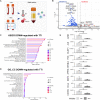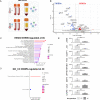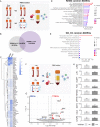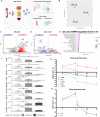Comparative analysis of methods to reduce activation signature gene expression in PBMCs
- PMID: 38155174
- PMCID: PMC10754832
- DOI: 10.1038/s41598-023-49611-2
Comparative analysis of methods to reduce activation signature gene expression in PBMCs
Abstract
Preserving the in vivo cell transcriptome is essential for accurate profiling, yet factors during cell isolation including time ex vivo and temperature induce artifactual gene expression, particularly in stress-responsive immune cells. In this study, we investigated two methods to mitigate ex vivo activation signature gene (ASG) expression in peripheral blood mononuclear cells (PBMCs): transcription and translation inhibitors (TTis) and cold temperatures during isolation. Comparative analysis of PBMCs isolated with TTis revealed reduced ASG expression. However, TTi treatment impaired responsiveness to LPS stimulation in subsequent in vitro experiments. In contrast, cold isolation methods also prevented ASG expression; up to a point where the addition of TTis during cold isolation offered minimal additional advantage. These findings highlight the importance of considering the advantages and drawbacks of different isolation methods to ensure accurate interpretation of PBMC transcriptomic profiles.
© 2023. The Author(s).
Conflict of interest statement
The authors declare no competing interests.
Figures





Similar articles
-
The effects of storage temperature on PBMC gene expression.BMC Immunol. 2016 Mar 15;17:6. doi: 10.1186/s12865-016-0144-1. BMC Immunol. 2016. PMID: 26979060 Free PMC article.
-
Investigating gene expression profiles of whole blood and peripheral blood mononuclear cells using multiple collection and processing methods.PLoS One. 2019 Dec 6;14(12):e0225137. doi: 10.1371/journal.pone.0225137. eCollection 2019. PLoS One. 2019. PMID: 31809517 Free PMC article.
-
Effects of cold exposure revealed by global transcriptomic analysis in ferret peripheral blood mononuclear cells.Sci Rep. 2019 Dec 27;9(1):19985. doi: 10.1038/s41598-019-56354-6. Sci Rep. 2019. PMID: 31882687 Free PMC article.
-
TLCD4 as Potential Transcriptomic Biomarker of Cold Exposure.Biomolecules. 2024 Aug 1;14(8):935. doi: 10.3390/biom14080935. Biomolecules. 2024. PMID: 39199323 Free PMC article.
-
Quantitation of intracellular triphosphate metabolites of antiretroviral agents in peripheral blood mononuclear cells (PBMCs) and corresponding cell count determinations: review of current methods and challenges.Expert Opin Drug Metab Toxicol. 2018 Aug;14(8):781-802. doi: 10.1080/17425255.2018.1500552. Epub 2018 Jul 25. Expert Opin Drug Metab Toxicol. 2018. PMID: 30010446 Review.
Cited by
-
Transcriptomic analysis unveils bona fide molecular signatures of microglia under conditions of homeostasis and viral encephalitis.J Neuroinflammation. 2024 Aug 17;21(1):203. doi: 10.1186/s12974-024-03197-2. J Neuroinflammation. 2024. PMID: 39153993 Free PMC article.
-
Multi-modal generative modeling for joint analysis of single-cell T cell receptor and gene expression data.Nat Commun. 2024 Jul 3;15(1):5577. doi: 10.1038/s41467-024-49806-9. Nat Commun. 2024. PMID: 38956082 Free PMC article.
References
MeSH terms
Grants and funding
LinkOut - more resources
Full Text Sources
Molecular Biology Databases

